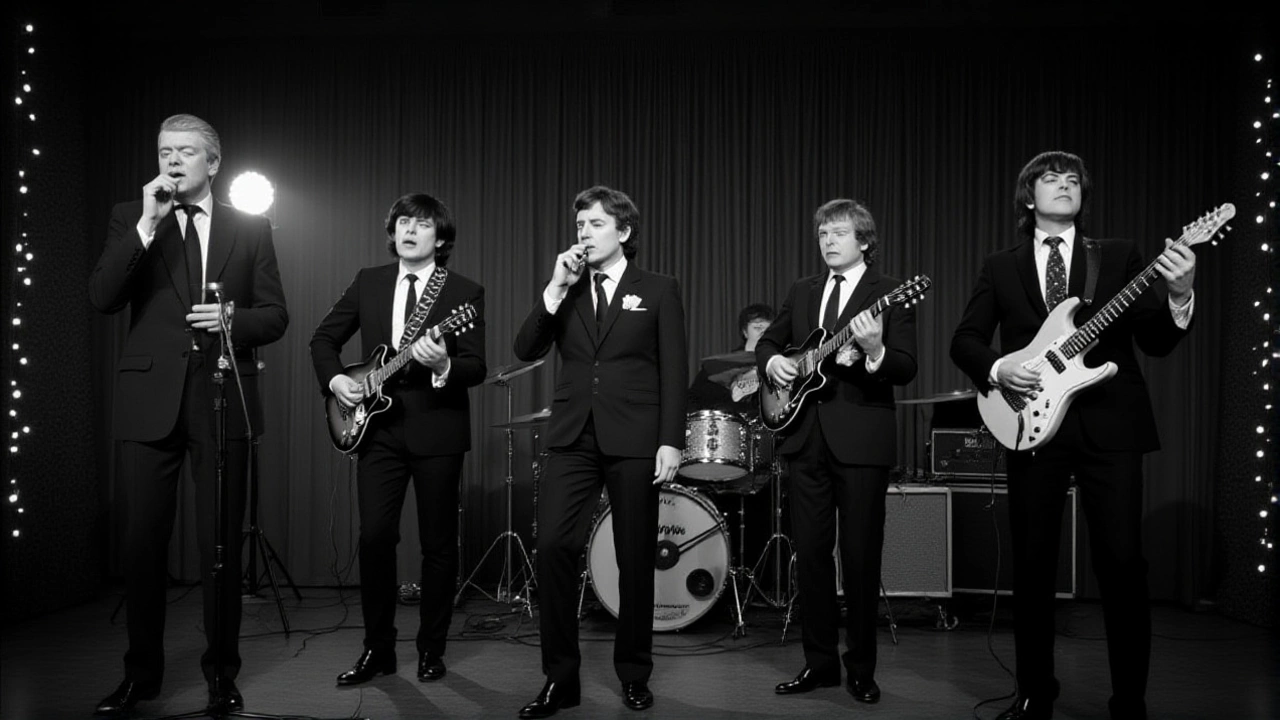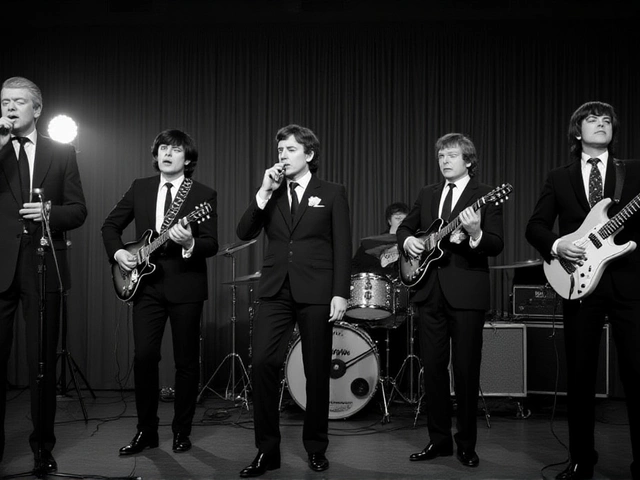For the first time in over six decades, the raw, unfiltered beginnings of one of rock’s greatest bands are laid bare. One hundred never-before-seen photographs of The Rolling Stones, taken during their chaotic, electrifying debut tour in 1963, will go on display at Dockside Vaults in London’s E1W 1AT district, opening June 3, 2025. The exhibition, titled Rolling Stones UnseenDockside Vaults, Ivory House, isn’t just another nostalgia trip—it’s a time machine. These images, captured by little-known photographer Gus Coral, show the band before fame, before hit records, before the world knew their names. Just six young men in damp clubs, sweating under flickering lights, playing for beer money and the thrill of the next chord.
Het begin van een legende, voordat de wereld keek
1963 was the year The Rolling Stones weren’t yet legends—they were just a band trying to survive. Mick Jagger, barely 20, still had his schoolboy accent. Keith Richards was living off fish and chips and borrowed amps. Brian Jones, the quiet genius with the slide guitar, was the band’s de facto leader. Bill Wyman and Charlie Watts had only just joined. And Ian Stewart? He played piano on stage, but wasn’t even listed as a member anymore—though he was still there, every night, keeping the rhythm alive. These photos freeze that moment: the moment before the world changed.
Before ‘Come On’ hit the charts. Before ‘(I Can’t Get No) Satisfaction’ was even a thought. Before Brian Jones was a household name—or a cautionary tale. These are the shots taken in smoky basement clubs in Birmingham, Manchester, and London’s East End. No stage lights. No security. No press. Just a camera, a flash, and a band that didn’t know they were writing history.
De foto’s die 62 jaar lang verborgen bleven
How did these photos survive? That’s the mystery. Gus Coral, a freelance photographer with ties to London’s underground jazz and R&B scene, was granted rare access during the band’s earliest gigs. He didn’t just take posed portraits—he captured the chaos: Mick Jagger mid-leap, Keith’s fingers sliding off a broken string, Brian Jones leaning into a harmonica solo with his eyes shut like he was praying. One image shows Charlie Watts, barely 23, drumming with the calm of a man who already knew he was different. Another shows Ian Stewart, shirtless in the back, wiping sweat, grinning like he’d just won the lottery.
After the tour, Coral stored the negatives in a damp basement in Hackney. They stayed there—unseen, unprocessed, forgotten—until 2023, when his daughter, cleaning out his attic, found them wrapped in oilcloth and labeled ‘Stones ‘63.’ She contacted the band’s archivist. The rest? History.
De locatie: een voormalige dokkelder met ziel
The choice of Dockside Vaults isn’t accidental. Once a storage bunker for shipping crates along the Thames, the space has been stripped back to its brick bones—exposed pipes, concrete floors, low ceilings. No white walls. No sterile lighting. The organizers wanted visitors to feel like they’d walked into a 1963 club. The air smells faintly of old wood and damp wool. Soundproofed walls play a loop of live recordings from that year: a scratchy version of ‘I’m a King Bee,’ the crowd screaming over a broken amp.
And here’s the twist: your £15 ticket includes a free drink—beer, wine, or soda. It’s not a gimmick. It’s a ritual. The organizers want you to stand there, glass in hand, and imagine what it felt like to be there. To be young. To believe that music could change everything.
Waarom dit alles nu?
2025 marks 62 years since these photos were taken. Coincidentally, it’s also the year the last surviving member of the original 1963 lineup—Charlie Watts—would have turned 85 had he lived. His absence is felt. The exhibition doesn’t glorify the past—it honors it. There’s no merch stall. No holograms. Just photos. And silence.
Music historians are calling this the most significant find in British rock photography since the lost shots of The Beatles’ Cavern Club days. And while the band themselves haven’t publicly endorsed the show, insiders say Mick Jagger saw a preview last month. He didn’t say much. But he stayed for an hour. And left with a bottle of bourbon.
Wat betekent dit voor fans en cultuur?
This isn’t just about rock history. It’s about how culture is made—not by PR teams, but by sweat, noise, and hunger. These photos show a band that didn’t know they were special. That’s the magic. They weren’t trying to be icons. They were just trying to get paid for their music.
For younger fans who only know The Rolling Stones as a nostalgia act on stadium tours, this exhibition is a revelation. It shows that greatness doesn’t start with a contract. It starts with a broken guitar, a cold stage, and a kid screaming into a mic like his life depends on it.
Wat komt er daarna?
Organizers say this is just the beginning. A limited-edition photobook is planned for late 2025, and there are talks of a touring version hitting Amsterdam and Berlin in 2026. Rumors also suggest that 20 more unseen reels of 16mm film from Coral’s archive are being restored—footage of the band backstage, laughing, arguing, eating sausages out of a tin.
For now, though, it’s just these 100 photos. And the silence between them.
Veelgestelde vragen
Wie zijn de personen op de foto’s en wat was hun rol in de band in 1963?
De foto’s tonen de oorspronkelijke bezetting van The Rolling Stones uit 1963: Mick Jagger (zang), Keith Richards (gitaar), Brian Jones (gitaar, harmonica), Bill Wyman (bas), Charlie Watts (drums) en Ian Stewart (piano). Stewart was al in 1963 officieel verwijderd uit de bandlijst, maar bleef als toetsenist en roadmanager actief. De foto’s vangen hen op in kleine clubs, nog voordat ze een platencontract hadden.
Waarom zijn deze foto’s zo lang verborgen gebleven?
De foto’s werden gemaakt door fotograaf Gus Coral, die ze na de tour in een vochtige kelder in Hackney bewaarde. Zijn dochter ontdekte ze in 2023, bij het opruimen van zijn bezittingen. Ze waren nooit ontwikkeld, nooit gepubliceerd. De negatieven waren zo goed als vergeten—tot de bandarchivaris er per toeval van hoorde. De opsporing duurde meer dan een jaar.
Wat maakt deze expositie uniek vergeleken met andere Rolling Stones-tentoonstellingen?
Voor het eerst worden foto’s getoond die gemaakt zijn tijdens hun *eerste* tournee—niet tijdens hun doorbraak of later succes. Andere tentoonstellingen focussen op de jaren ’70 of ’80. Dit is de enige expositie die de band toont als onbekende jongens, zonder make-up, zonder managers, zonder publiciteit. De foto’s zijn ongefilterd, niet geselecteerd door de band zelf.
Hoe is de locatie Dockside Vaults voor de expositie aangepast?
De voormalige dokkelder is opnieuw ingericht met donkere wanden, houten planken en oude luidsprekers die muziek van de echte concerten van 1963 afspelen. Er zijn geen lichtbakken of digitale schermen—alleen de foto’s, in zwart-wit, met natuurlijk licht. De luchtgeur is bewust aangepast: een mix van oud hout, tabak en een vleugje oud bier. Het is een sensorische ervaring, geen museum.
Zijn er nog meer ongeziene materialen van deze periode?
Ja. Er zijn 20 minuten 16mm-filmbeelden opgespoord die Coral in 1963 maakte—vooral achter de schermen: bandleden die slapen in busjes, eten in cafés, en zelfs een scène waar Brian Jones een harmonica speelt op een straat in Nottingham. Deze worden momenteel gerestaureerd en zouden in 2026 als extra deel van een touringversie van de expositie kunnen worden getoond.
Waarom is de prijs van £15 met een drankje inclusief?
De organisatoren willen dat bezoekers zich voorstellen hoe het was om in 1963 naar een Rolling Stones-concert te gaan: een kamer vol rook, een biertje in de hand, en een band die nog niet wist dat ze wereldberoemd zouden worden. Het drankje is geen bonus—it’s part of the experience. De prijs is bewust laag gehouden om jongere fans en studenten toegang te geven. Het is geen luxe-expositie. Het is een herinnering.

